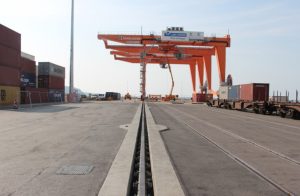
The port of Koper, Slovenia, inaugurated on Tuesday the crane rail tracks and the two new RMG cranes which are to substantially increase train loading capacity at the container terminal, as announced in its press release.
The RMG technology has never been applied in Luka Koper before. The introduction of the new technology required the construction of 740-metre-long tracks and removal of some warehousing blocks. Today, instead of three railway tracks previously extended, the terminal operates five tracks in total, meaning that five container trainsets can be handled simultaneously. This will significantly contribute to the productivity of the port’s container operations.
About 60% of containers leave Luka Koper by train, which places the port at the leading position in the Adriatic region in this segment. “At the container terminal, we register on average 24 arrivals and departures of block trains per day and these trains connect Koper with all industrial centres of Central Europe”, said at the ceremony Dragomir Matić, President of the management board of Luka Koper.
He also has stressed that the company will continue investing in the container terminal to increase its capacity up to 1.3 mln TEU. In 2016 Luka Koper handled 844,000 TEU.
The accomplished rail tracks construction and the purchase of the new 300-tonnes, electricity driven RMG cranes, with one more to be delivered in the next months, Luka Koper has successfully completed the first stage of its substantial investment program. By 2020, the port plans to invest EUR 235 mln in the same terminal. This will include berth extension by 100m and construction of additional container yard in the terminal’s hinterland. Also, two new super post-panamax STS cranes will be delivered next month, which will allow the port handle the largest container ships of 20,000 TEU capacity.
Since 2014 the company has already invested EUR 124 mln in the development, which increased the port’s throughput from 17.9 mln tonnes in 2013 to 22 mln tonnes in 2016. The highest growth was registered in the two strategic cargo segments: cars (by 62% since 2013) and containers (by 40% since 2013).
